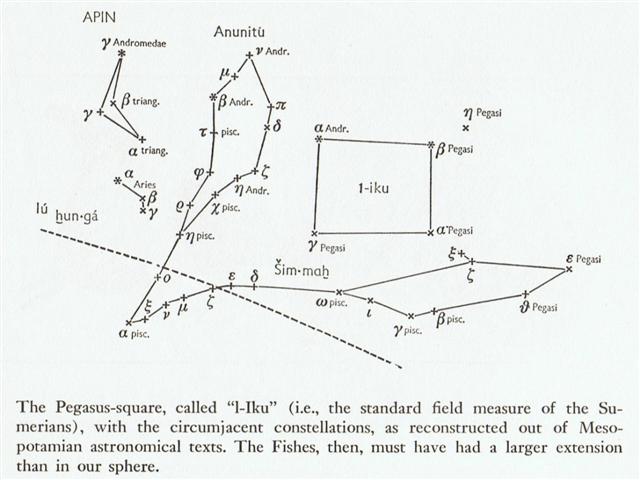8. It is time to answer a question: Why should Rogo in Gb6-26 correspond to the position of Sirrah and day 1 after spring equinox (north of the equator) according to the right ascension of today? Why not instead some other star which was positioned at day 1 after equinox at the time when the G text was created? The precession of the equinoxes moves the stars forward in the solar year with 1 day in about 26,000 / 365 = ca 70 years. I think the answer is that anciently Sirrah ('The Woman in Chains') personified the new year which was released from the dark nights of winter solstice. A new 'land' came at the end of these days - which were in hikuvai ('splashing-water'), the last phase of the 'water' beyond autumn equinox. Once, a long time ago, the Pegasus Square was positioned immediately after winter solstice. Hamlet's Mill: "Utnapishtim is spry enough to tell [Gilgamesh] in great detail the story of the Deluge. He tells how Enki-Ea has warned him of Enlil's decision to wipe out mankind, and instructed him to build the Ark, without telling others of the impending danger. 'Thus shalt thou say to them: (I will ... go) down to the apsu and dwell with Ea, my (lor)d.' He describes with great care the building and caulking of the ship, six decks, one iku (acre) the floor space, as much for each side, so that it was a perfect cube [a sign of Saturn], exactly as Ea had ordered him to do. This measure '1-iku' is the name of the Pegasus-square, and the name of the temple of Marduk [the spring sun god] in Babylon, as is known from the New Year's Ritual at Babylon, where it is said: 'Iku-star, Esagil, image of heaven and earth.'
"... Esagila is '1-iku - the Pegaus-square between the two Fishes that ruled the hibernal solstice during the Age of Gemini ..." I suggest the Polynesians knew the Pegasus Square once stood at the threshold to the new year. Which takes care of the question of why Sirrah should correspond to Rogo - both are positioned at the beginning of new year. The Square of Pegasus has moved to spring equinox since the time when Gemini was at spring equinox:
But the idea of 'land' (like a raft surrounded by fishes) beginning with the Square of Pegasus has remained. Therefore the front side of the year should begin with its α star Sirrah. The observer on Easter Island knew, however, which star he should search for instead of Sirrah when it was close to a solstice, a star ca 90º away from Sirrah (which the full moon should visit). It is just a coincidence that the great 26,000 year long cycle of the precession has turned a quarter since the age of Gemini, but for practical purposes it is nice because the observer on Easter Island would have known that Sirrah should be together with Sun around autumn equinox, a quarter before winter solstice. |

